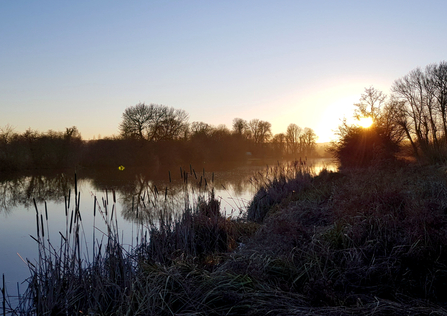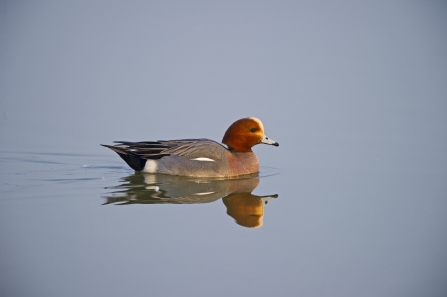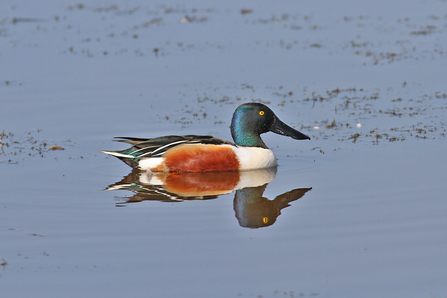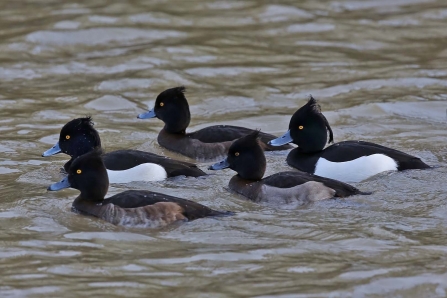
Sunrise at Cholsey Marsh by Charlotte Day - winner of the landscape category in the BBOWT Photography Competition 2022.
English oak leaves in autumn by Ross Hoddinott/2020VISION

Sunrise at Cholsey Marsh by Charlotte Day - winner of the landscape category in the BBOWT Photography Competition 2022.
Pause on a walk along the Thames Path to explore Cholsey Marsh nature reserve. Riverside marshes such as this are now scarce because of large-scale drainage.
This nature reserve is home to a wealth of plants, insects and birds that depend on the wet reed and sedge beds. It's a favoured roosting site for wagtails, corn and reed buntings so look out for them gathering if you're there close to dusk.
You might come across some of our Dexter cattle, which do an important job of grazing our nature reserves. Please leave them in peace and don't try to feed or touch them.
Access: Flat overall, soft after rain; kissing gates, gates

Wigeon by David Tipling/2020VISION
Enjoy watching the comings and goings of migrating waterfowl in this quiet corner of Buckinghamshire. Created in 1956 by damming a small tributary of the River Great Ouse, Foxcote Reservoir has become important for the numbers of wintering waterfowl, especially wigeon, coot and tufted duck.
These are often joined by smaller numbers of goldeneye, goosander, teal, shoveler and occasionally pintail, striking visitors from further afield.
Access: Gentle slope. Wheelchair access possible in dry weather.

Fly agaric fungus mushroom. Picture: Jon Hawkins/ Surrey Hills Photography
This ancient woodland is famed for spectacular autumn colours and fabulous fungi. Over 200 species have been recorded including boletes, russulas, milkcaps and false death cap. Look out for the bright red beechwood sickener poking out from the fallen beech leaves, the fly agaric – the classic red and white fairytale toadstool, and the blue-grey oyster mushroom, growing in tiers at the base of trees.
Explore the reserve and surrounding countryside with our circular 11km/7 mile Wild Walk.
Access: Gently sloping; mainly grassy, soft when wet, some roots, gaps (0.5m wide), kissing gate. Off-road pushchair recommended.

Beech trees in autumn at Hog and Hollowhill Woods. Picture: Cathie Hasler
These woods near Marlow lie within the Chilterns Beechwoods Special Area of Conservation and the Chilterns Area of Outstanding Natural Beauty. They are also part of the Hollowhill and Pullingshill Woods Site of Special Scientific Interest. Beech trees dominate the woods but there are also other species here including oak, ash, field maple, birch, larch and yew.
In autumn the beech leaves turn golden orange and the shady woodland floor supports an amazing array of fungi - more than 150 species have been recorded on this reserve.
Access: No easy access trails

Shoveler © Gary Cox
Hosehill Lake is one of several lakes that form the Theale Gravel Pits Complex. These former extraction sites were flooded to form the lakes in the early 1980s and they are all interconnected. Follow the path around the lake to look out for visiting winter birds including shoveler and wigeon.
Access: Mix of grass and surfaced paths, flat around northern part of lake, undulating to south. Narrow bridges. Lakeside paths muddy in winter. Bicycles and horse riding not permitted.

Tufted ducks by Margaret Holland
Another flooded gravel pit, Loddon Nature Reserve is a great site to look for wintering birds such as gadwall, tufted duck and pochard. Herons and sometimes little egrets hunt for food at the water's edge while songbirds flit around in the trees and scrub.
Access: Flat; partly flooded in winter with muddy, short slopes; gate, boardwalk